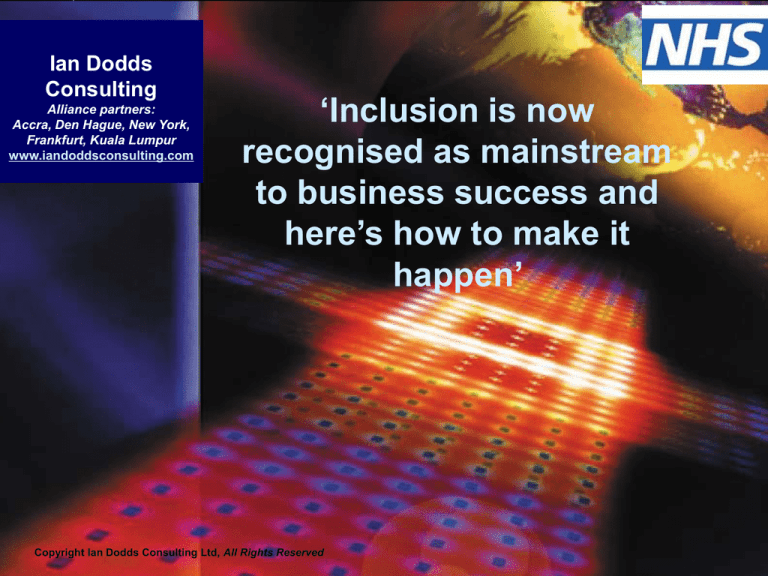
Ian Dodds
Consulting
Alliance partners:
Accra, Den Hague, New York,
Frankfurt, Kuala Lumpur
www.iandoddsconsulting.com
‘Inclusion is now
recognised as mainstream
to business success and
here’s how to make it
happen’
Copyright Ian Dodds Consulting Ltd, All Rights Reserved
0
What we’ll discuss
■ How do Diversity and Inclusion contribute to success?
■ Leveraging the Power of Inclusion to deliver high performance
■ Some successful case studies
How do Diversity & Inclusion contribute to
success?
2
The big performance benefits from managing diversity
happen when an inclusive environment is created
Inclusion
Diversity
Every way in
which any
mixture of people
has both
similarities and
differences
■ It is about a culture where each
person:
− Feels respected & valued
− Feels their ideas & opinions are
heard
− Can perform to their full potential
■ It involves sustained and long-term
strategic effort
■ It’s happening when diversity of
thought is embraced in finding the
best ways to serve clients and
customers
Organisations with great leaders and great managers
capitalise on what’s similar and different about people:
Great leaders – find out what is similar and capitalise on it to
rally people to create a better future for their organisation.
Great managers – find out what is different about people and
turn each person’s talents into performance both for now and
for the future.
(Adapted from Marcus Buckingham)
4
Diversity has many elements and these impact on how we
interact with others, solve problems and make decicions
INTERACTING
Level
Function
Marital/Parental Status
How we
communicate
How we see
ourselves – (group
or individual)
Social status
Age
Personality/
Values/Beliefs
Primary
Appearance
Secondary Organisational
Physical &
Mental Ability
Race
Religion
PROBLEM SOLVING
Language/Accent
Sexual
Orientation
Gender
Division
Nationality
Ethnicity
What we focus on:
task vs. relationship
How we give
explanations
Location
Sector
Hobbies
Educational
Background
How we make
conclusions
DECISION MAKING
Location
Career Motivations
How we process
information
How much we try to
control
How we see time
How we organise power
Managing Diversity and Inclusion Involves Culture Change to
deliver the big performance benefits
Equal
Opportunities
Race, Gender,
Disability
Valuing
Differences
All the ways we are
different
Focus
Motivation
Change
Required
Result
Legal responsibility
Individual
adapts
More women
and minority
ethnic people
Managing Risk
Social and moral
responsibility
Mutual
accommodation
Mutual respect
Managing Risk
Managing
Diversity & Inclusion
Creating an
inclusive work
environment
Meeting
stakeholders’
needs
Culture embraces
difference
Responsive
services/
Better problem
solving/
Performance gains
High Performance
6
When an organisation is inclusive it gains significant
performance benefits:
1. Reduced recruitment costs and a greater talent pool
2. Raised employee motivation and productivity
3. Enhanced Employer Brand
4. New ideas and better products and services for customers and
service users
(Source: Harnessing Workforce Diversity , Create
– survey of 400 organisations investing in D&I)
5. Great teamwork through enhanced interactive effectiveness
(Source: Prof Sandy Pentland, HBR, Apr 2012)
7
Diverse teams consistently outperform homogeneous
teams in solving problems
Diversity trumps ability theorem:
There are 2 conditions:
1. The problem has to be complex.
2. Team members have to listen to each other and
explore differing ideas and points of view.
(Prof Scott E Page)
Leveraging the Power of Inclusion to deliver high
performance
Leveraging the Power of Inclusion successfully takes longterm strategic effort, involving 5 stages
Stage 1
Unfreeze
Stage 2
Mobilise
Diagnostic to
find out what is
helping and
hindering
inclusion for
different
diversity
groups
Set up a D&I
Steering Group
to formulate a
Diversity &
Inclusion
strategy
Stage 3
Realise
Implement the
Diversity &
Inclusion
strategy
Stage 4
Embed
Stage 5
Sustain
1. Senior
1. Communicat
managers
e Diversity &
role model
Inclusion
inclusive
success
behaviour
stories
2. Ensure
2. Keep up to
management
date on
processes &
Diversity &
systems are
Inclusion best
inclusive
practices
In Stage 1 a diagnostic needs to be conducted
Stage 1
Unfreeze
Diagnostic to find out what is helping and
hindering inclusion for different
diversity groups
We do this via:
1. Our online Power of Inclusion diagnostic survey tool.
2. Affinity focus groups, using our highly effective template
based on behavioural change methodology.
3. Key employee interviews, using our highly effective
template based on behavioural change methodology.
It is the emotional impact of stories and quotes which generate
the will to act by senior management
In Stage 2 a an Inclusion Steering Group is established
Stage 2
Mobilise
Set up an Inclusion Steering Group to
formulate a Diversity & Inclusion strategy
The Inclusion Steering Group needs to:
1.
2.
3.
4.
Acquaint itself with the findings of the diagnostic.
Educate itself on D&I Best Practices.
Guide any Task Groups it sets up, e.g. on flexible working.
Formulate the D&I strategy and underpin it with
behavioural change methodology.
In Stage 3 the Diversity and Inclusion Strategy is rolled out
Stage 3
Realise
Implement the Diversity & Inclusion
strategy
The Inclusion Steering Group needs to:
1. Lead, monitor and measure the implementation of the D&I
strategy.
2. Provide inclusion and diversity management training for
senior managers.
3. Provide unconscious bias training for senior managers,
including knowing how it plays out in relation to gender,
cross-cultural and generational differences.
4. Provide development activities, e.g. Mentoring Circles, to
develop high potentials from all diverse backgrounds.
5. Develop eLearning programme offerings on relevant
aspects of diversity and inclusion.
In Stage 4 leadership role modelling is critical and talent
management processes need to be proofed
Stage 4
Embed
1. Senior managers role model
inclusive behaviour
2. Develop great, inclusive teams
3. Ensure management processes
& systems are inclusive
The Inclusion Steering Group needs to:
1. Offer a workshop for leaders to ‘pinpoint’ the behaviours
they need to role model to drive their business strategy,
values or inclusion.
2. Introduce leadership behaviour pulse survey feedback.
3. Provide behavioural coaching for the leaders.
4. Train interactive effectiveness coaches, using our unique
interactive behaviours tool.
5. Proof all talent management processes and systems to
ensure that they are inclusive and free of unconscious bias.
Between 80% and 90% of behaviour in an organisation is
influenced by what leaders do and say
What the leader attends to, measures, rewards and controls
Leader reaction to critical incidents
Leader behavioural role modeling
Most
influential
Criteria for recruitment, promotion, retirement and exit
Formal and informal socialisation
Recurring systems and procedures
Organisation design and structure
Design of physical space
Stories and myths about key people and events
Formal statements, charters, creeds, codes of ethics
(Adapted from
Ed Schein)
(Professor Ed Schein)
15
The interactive behaviours that power inclusion
and great teams
‘Telling’
Objectives and why
important
Giving information
Making content suggestions
Making process suggestions
Summarising
Disclosing
- Information known only to
you
- Something about self
Summarising outcomes and
follow-up
‘Seeking’
Seeking information
Seeking suggestions
Checking understanding
Developing suggestions
Acknowledging
Content
Feelings
Bring-in
-
In Stage 5 reinforcing best practice is important
Stage 5
Sustain
1. Communicate Diversity &
Inclusion success stories
2. Develop Inclusion Champions
3. Keep up to date on Diversity &
Inclusion best practices
The Inclusion Steering Group needs to:
1. Identify and collect inclusion success stories.
2. Train internal Inclusion Champions.
3. Develop a means to keep up to date on diversity and
inclusion best practices.
Cisco Systems EMEA: innovation is the key driver
■ Innovation is seen to be critical and US experience indicates that a
inclusion is an innovation driver
■ Business case made by the CEO finding out by listening to stories from
women and Minority Ethnics that it needs to address unconscious bias
■ Inclusion Steering Group formulates the D&I strategy
■ Behavioural training for senior management
■ Task group on flexible working
■ Internal Inclusion Ambassadors help to drive the transformation
■ Website engages employees by providing opportunities to feature D&I
successes
1. More people from underrepresented groups, recruited, promoted &
retained.
2. Levels of inclusion being rated highly by external benchmarking
agencies.
3. Increased innovation measured by Cisco’s innovation portal.
Quote from a UK newspaper by a fly-on-the wall business
reporter demonstrating the Power of Inclusion in an HMRC
Office
“I don’t think I have ever been in an office with
a stronger sense of purpose, contentment,
candour, coherence or vigour”
Questions?







